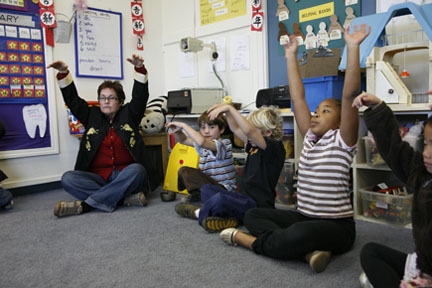By Megan Cowa
How can we build the quality of mindfulness in our children, our classrooms, and our schools?
The Oakland-based Mindful Schools program, of which I am a co-founder and co-director, teaches children in public and private elementary, middle, and high schools how to be more mindful of their thoughts and actions. As of the fall of 2009, Mindful Schools had brought our five-week in-class mindfulness training to over 7,000 children in 26 schools, 22 of which serve low-income children. The program is secular, extremely cost-effective, and uses short, interactive exercises that are tailored for children. Both quantitative and qualitative responses from teachers, principals, and students have indicated that our program greatly improves the classroom and the overall school environment.
Here are some guidelines that Mindful Schools has created for educators who want to incorporate mindfulness into the school day, or for anyone who wants to teach mindfulness to children, based on our experiences with Mindful Schools.
Purpose. Because this is a tool that students can utilize throughout their life, it is important that the connotation of “mindfulness” remains accurate. Mindfulness, when applied appropriately, includes the qualities of awareness (paying attention to one’s experience through the senses and the mind); of non-judgment (not labeling things “good” or “bad” but rather observing with a neutral attitude); and of stillness in heart and mind (though the body may be moving). Although it may be tempting to use mindfulness as a disciplinary tool, mindfulness should not be used to demand a certain behavior. It inherently includes the quality of acceptance.
Have your own mindfulness practice. This will make you more effective at teaching mindfulness. We can only offer what we have developed ourselves.
Choose a time for mindfulness. We are creatures of habit! Try to always practice mindfulness at the same time. Many teachers find mindfulness helps their class settle down after recess or after lunch. Of course, you may do it more than once a day.
Create the environment. Make it clear that mindfulness is a special time: clear off desks, perhaps move to the carpet, or have all chairs face the front of the room. Ask students not to take bathroom breaks and refrain from talking and moving for a little while.
Get the students involved. The best way to make sure you remember to do mindfulness is to enlist the help of your students. Create a rotation schedule for “who gets to ring the mindfulness bell.” If you practice mindfulness at the same time every day, pretty soon you won’t have to remember—whoever’s turn it is will remind you!
You share. Because children respond well when we relay our own experiences, you can share with the students if, how, and when you are using mindfulness in your life. If you share a recent story of when you were overcome with emotion or used mindfulness to help you deal with an emotion, they can hear how it is applied.
They share. Many young students like to share what they’ve noticed or experienced during mindfulness, or maybe something that was challenging or distracting. Sharing also allows others to be aware of things to notice while practicing mindfulness that they may not have heard otherwise.
Practice every day! The sooner you begin integrating mindfulness exercises into your daily classroom routine, even for just a minute at a time, the quicker it will become a part of the classroom culture.
Use the instructions and script below for a daily mindfulness lesson; it can be done in just one or two minutes. If you like, you can get more creative and add more in-depth lessons, or practice for longer periods. You can do the same thing every day. A simple lesson to repeat daily is one minute of mindful listening and one minute of mindful breathing.
1. “Please get into your ‘mindful bodies’—still and quiet, sitting upright, eyes closed.”
2. “Now place all your attention on the sound you are about to hear. Listen until the sound is completely gone.”
3. Ring a “mindfulness bell,” or have a student ring the bell. Use a bell with a sustained sound or a rainstick to encourage mindful listening.
4. “Please raise your hand when you can no longer hear the sound.”
5. When most or all have raised their hands, you can say, “Now slowly, mindfully, move your hand to your stomach or chest, and just feel your breathing.”
6. You can help students stay focused during the breathing with reminders like, “Just breathing in … just breathing out …”
7. Ring the bell to end.
